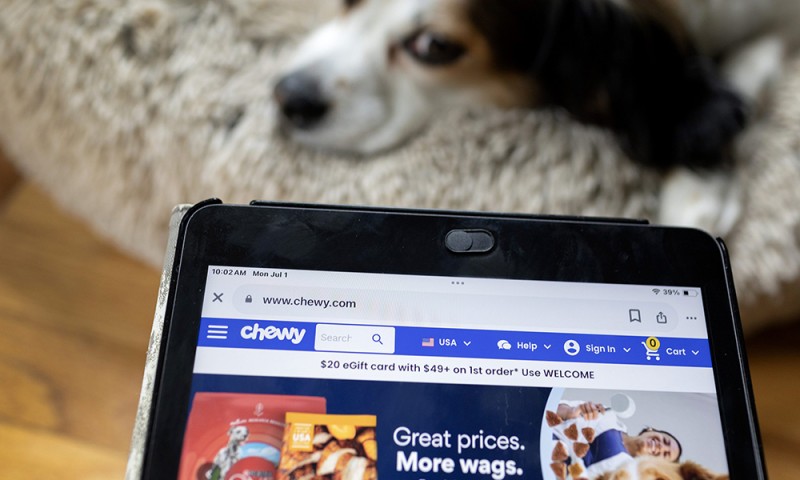
美国人对宠物的宠爱催生了规模庞大的产业。2024年,美国家庭仅在兽医护理和宠物药品上的支出就接近400亿美元,成为仅次于宠物食品和零食的第二大宠物消费类别。据预测,到2027年,更广泛的宠物市场规模将达到1730亿美元;随着疫情期间收养的数百万宠物步入老年、医疗护理需求激增,兽医护理支出预计将加速增长。美国银行(Bank of America)研究部由高级分析师柯蒂斯·内格尔(Curtis Nagle)领导的团队对这家在线零售商的规划展开研究后发现,它正转型为完全不同类型的公司。Chewy的起源可追溯至游戏驿站(GameStop)首席执行官莱恩·科恩(Ryan Cohen)的创意——他曾是“迷因股”名人,而如今Chewy已突破其初始定位。从在线宠物食品零售商起步,它已发展成为一家市值160亿美元的上市公司,拥有超过2000万客户。(科恩于2017年以33.5亿美元出售了Chewy。)
在此过程中,Chewy还成为美国最大的在线宠物药房,年销售额达11亿美元,占据7%的市场份额。然而,内格尔的团队估计,目前仅有约四分之一的Chewy客户使用其药房服务,这表明其增长空间巨大。他们表示,若服务渗透率提升至40%,尤其是随着宠物年龄增长、对药物需求增加,Chewy有望额外斩获7.5亿美元的销售额。
美国爱护动物协会(ASPCA)估计,疫情期间美国人收养了2300万只宠物。美国银行指出,这些宠物如今正步入中年,使得兽医就诊愈发频繁、药物使用和专业护理需求增加。该行预计宠物健康行业将以每年4%的速度增长,且随着疫情期间收养的宠物年龄增长,2026年和2027年的增长速度可能会加快。
Chewy的下一阶段:从宠物食品到诊所
Chewy进军兽医诊所业务,以Chewy Vet Care(CVC)品牌运营,开局良好。首批11家诊所在谷歌平台获得超1000条评论,平均评分达4.8分(满分5分)。客户称赞其现代化设施、透明定价以及与Chewy在线生态系统的无缝衔接。管理层向美国银行研究部表示,早期数据“极为鼓舞人心”,称CVC在客户参与度和新客户获取方面均超出预期。
比如,有则好评言简意赅:“向来喜欢这家公司,如今它开设了兽医诊所,对Chewy而言堪称双赢之举。”
负面评论则提到高昂费用和诊断问题。一位客户称“从未为一次健康检查支付过如此高昂的费用”,另一位客户则称CVC给自家宠物开的是类固醇,而非所需的抗生素。
美国银行认为,Chewy具备快速扩张其兽医医院业务的潜力。从财务数据来看,Chewy约三分之一的资本支出用于增长计划,该行认为其有能力大幅加快扩张步伐。分析师估计,若Chewy将15%的资本支出投入兽医诊所,到2030年CVC有望实现3.35亿美元收入,息税折旧摊销前利润(EBITDA)利润率为20%——这将使华尔街当前的息税折旧摊销前利润预期提升4%。
Chewy在全美拥有17个配送中心,宣称能够为80%的人口提供次日达服务,为近乎100%的人口提供两日达服务。其药房配送中心数量较少,但已构建起覆盖全国的配送网络,且具备进一步扩张的潜力。
根据美国兽医协会(AVMA)的数据,美国拥有超3.4万家兽医诊所,且呈现出分散态势。毕马威(KPMG)估计,全美约30%的兽医诊所为私募股权公司拥有,20%为企业持有,剩余50%多为独立诊所。其中规模最大的几家企业包括Mars Veterinary Health、National Veterinary Associates、SVP & MVP、Thrive Pet Healthcare和Petco,其在美国的兽医诊所数量从约300家到2000多家不等。这意味着Chewy在这一领域尚处于起步阶段。
Chewy向兽医护理和药房领域的扩张,使其有望在蓬勃发展的宠物健康市场中占据更大份额。美国银行估计,随着公司扩大诊所规模并提高药房服务渗透率,有望新增逾10亿美元收入。这无疑是值得深耕的大市场。
Chewy拒绝置评。(*)
为撰写本报道,《财富》杂志使用生成式人工智能协助完成初稿。在发布前,编辑已核实信息准确性。
译者:中慧言-王芳
美国人对宠物的宠爱催生了规模庞大的产业。2024年,美国家庭仅在兽医护理和宠物药品上的支出就接近400亿美元,成为仅次于宠物食品和零食的第二大宠物消费类别。据预测,到2027年,更广泛的宠物市场规模将达到1730亿美元;随着疫情期间收养的数百万宠物步入老年、医疗护理需求激增,兽医护理支出预计将加速增长。美国银行(Bank of America)研究部由高级分析师柯蒂斯·内格尔(Curtis Nagle)领导的团队对这家在线零售商的规划展开研究后发现,它正转型为完全不同类型的公司。Chewy的起源可追溯至游戏驿站(GameStop)首席执行官莱恩·科恩(Ryan Cohen)的创意——他曾是“迷因股”名人,而如今Chewy已突破其初始定位。从在线宠物食品零售商起步,它已发展成为一家市值160亿美元的上市公司,拥有超过2000万客户。(科恩于2017年以33.5亿美元出售了Chewy。)
在此过程中,Chewy还成为美国最大的在线宠物药房,年销售额达11亿美元,占据7%的市场份额。然而,内格尔的团队估计,目前仅有约四分之一的Chewy客户使用其药房服务,这表明其增长空间巨大。他们表示,若服务渗透率提升至40%,尤其是随着宠物年龄增长、对药物需求增加,Chewy有望额外斩获7.5亿美元的销售额。
美国爱护动物协会(ASPCA)估计,疫情期间美国人收养了2300万只宠物。美国银行指出,这些宠物如今正步入中年,使得兽医就诊愈发频繁、药物使用和专业护理需求增加。该行预计宠物健康行业将以每年4%的速度增长,且随着疫情期间收养的宠物年龄增长,2026年和2027年的增长速度可能会加快。
Chewy的下一阶段:从宠物食品到诊所
Chewy进军兽医诊所业务,以Chewy Vet Care(CVC)品牌运营,开局良好。首批11家诊所在谷歌平台获得超1000条评论,平均评分达4.8分(满分5分)。客户称赞其现代化设施、透明定价以及与Chewy在线生态系统的无缝衔接。管理层向美国银行研究部表示,早期数据“极为鼓舞人心”,称CVC在客户参与度和新客户获取方面均超出预期。
比如,有则好评言简意赅:“向来喜欢这家公司,如今它开设了兽医诊所,对Chewy而言堪称双赢之举。”
负面评论则提到高昂费用和诊断问题。一位客户称“从未为一次健康检查支付过如此高昂的费用”,另一位客户则称CVC给自家宠物开的是类固醇,而非所需的抗生素。
美国银行认为,Chewy具备快速扩张其兽医医院业务的潜力。从财务数据来看,Chewy约三分之一的资本支出用于增长计划,该行认为其有能力大幅加快扩张步伐。分析师估计,若Chewy将15%的资本支出投入兽医诊所,到2030年CVC有望实现3.35亿美元收入,息税折旧摊销前利润(EBITDA)利润率为20%——这将使华尔街当前的息税折旧摊销前利润预期提升4%。
Chewy在全美拥有17个配送中心,宣称能够为80%的人口提供次日达服务,为近乎100%的人口提供两日达服务。其药房配送中心数量较少,但已构建起覆盖全国的配送网络,且具备进一步扩张的潜力。
根据美国兽医协会(AVMA)的数据,美国拥有超3.4万家兽医诊所,且呈现出分散态势。毕马威(KPMG)估计,全美约30%的兽医诊所为私募股权公司拥有,20%为企业持有,剩余50%多为独立诊所。其中规模最大的几家企业包括Mars Veterinary Health、National Veterinary Associates、SVP & MVP、Thrive Pet Healthcare和Petco,其在美国的兽医诊所数量从约300家到2000多家不等。这意味着Chewy在这一领域尚处于起步阶段。
Chewy向兽医护理和药房领域的扩张,使其有望在蓬勃发展的宠物健康市场中占据更大份额。美国银行估计,随着公司扩大诊所规模并提高药房服务渗透率,有望新增逾10亿美元收入。这无疑是值得深耕的大市场。
Chewy拒绝置评。(*)
为撰写本报道,《财富》杂志使用生成式人工智能协助完成初稿。在发布前,编辑已核实信息准确性。
译者:中慧言-王芳
Americans’ love for their pets is big business. In 2024, U.S. households spent nearly $40 billion on veterinary care and pet pharmaceuticals alone, making it the second-largest category of pet spending after food and treats. The broader pet market is projected to reach $173 billion by 2027, with veterinary care expected to accelerate as millions of pets adopted during the pandemic enter their senior years and require more medical attention. A team at Bank of America Research led by senior analyst Curtis Nagle looked at the online retailer’s plans, and found it’s morphing into another kind of company altogether. Chewy has already grown far beyond its origins as the brainchild of GameStop CEO Ryan Cohen, the one-time meme-stock celebrity. From its start as an online pet-food retailer, it’s grown into a public company with a $16 billion market cap and a customer base of more than 20 million. (Cohen sold Chewy for $3.35 billion in 2017.)
Along the way, Chewy has also become the largest online pet pharmacy in the U.S., with $1.1 billion in annual sales and a 7% market share. However, Nagle’s team estimates only about a quarter of Chewy’s customers use these pharmacy services, leaving significant room for growth. If penetration rises to 40%, they said, Chewy could unlock an additional $750 million in sales, especially as pets age and require more medications.
The ASPCA estimates Americans adopted 23 million pets during the pandemic, and BofA notes these animals are now reaching middle age, fueling demand for more frequent vet visits, medications, and specialized care. The bank sees the pet-health sector growing 4% annually, with a likely acceleration in 2026 and 2027 as the “COVID cohort” of pets ages.
Chewy’s next act: from kibble to clinics
Chewy’s foray into veterinary clinics, branded as Chewy Vet Care (CVC), is off to a promising start, with the first 11 clinics averaging 4.8 out of 5 stars out of more than 1,000 reviews on Google. Customers praise the modern facilities, transparent pricing, and seamless integration with Chewy’s online ecosystem. Management characterized the early data to BofA Research as “promising,” saying the CVCs are exceeding expectations in engagement and acquiring new customers.
For example, one positive review simply states: “Always loved the company and now them having a vet is a win-win for Chewy.”
Negative reviews mention high prices and diagnosis issues. One customer said they’d “never paid such a high price for a wellness visit,” while another said the CVC gave them steroids instead of antibiotics.
BofA thinks Chewy can grow its vet hospitals rapidly. Looking at its books, with about one-third of capital expenditure dedicated to growth initiatives, BofA sees capacity to pick up the pace significantly. If Chewy dedicates 15% of its capex to vet clinics, BofA analysts estimate the CVCs could generate $335 million in revenue by 2030, with 20% EBITDA margins—adding 4% to Wall Street’s current EBITDA estimates.
Chewy has 17 fulfillment centers nationwide and says it can deliver to 80% of the population overnight and almost 100% in two days. It has fewer pharmacy fulfillment centers, but it still boasts a nationwide footprint, with room to expand.
According to the AVMA, the U.S. has more than 34,000 vet clinics and the space is fragmented. KMPG estimates roughly 30% of the nation’s vet clinics are owned by private-equity firms and 20% by corporations, with the remaining 50% mostly independent. Some of the largest players are Mars Veterinary Health, National Veterinary Associates, SVP & MVP, Thrive Pet Healthcare, and Petco, which range from over 2,000 locations in the U.S. to roughly 300. That means Chewy is just getting started.
Chewy’s expansion into vet care and pharmacy positions it to capture a growing share of the booming pet health market. As the company scales its clinics and deepens its pharmacy penetration, BofA estimates that it could add over $1 billion in new revenue. That’s a lot to chew on.
Chewy declined to comment.
For this story, Fortune used generative AI to help with an initial draft. An editor verified the accuracy of the information before publishing.

